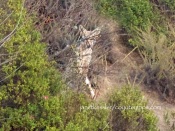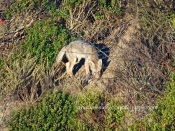- watching and waiting for parents to return
- hiding, watching and waiting from behind brambles
- investigating
Coyote youngsters are often left alone as their parents go off hunting or trekking. What do they do when they are left alone? They like to explore, sticking to the areas immediately around where their parents have left them — a healthy wariness and fear keeps them put.
From a substantial distance, I’ve seen them pounce on things, pull on sticks, wander around and mostly WATCH what is going on in the distance while sitting very still. If they catch you eyeing them, they’ll hurry away and hide, but first they’ll sit still for a few moments to confirm for themselves that you are actually looking at them. They may move to behind some minimal covering from where they’ll watch for another few minutes, and then, they’ll bound out of sight altogether where they know they will be safer.
It’s always an exciting event when parents return. After all, parents are not just providers and protectors, they are also playmates. When a parent returns, some of the pups’ shy wariness is tossed aside, but not all of it. For instance, seeing a dog in the distance is a red flag which causes youngsters to run for cover, even if a parent is right there.
With a parent at their side, they are willing to banter and play in little patches of exposed areas between the bushes, even if someone is watching — and they are always aware of all eyes on them — as long as the parent is comfortable with this. Pups take their cues from their parents: one whisper or “look” from a parent indicating that things might not be safe sends youngsters lickety-split into hiding.







Aug 01, 2015 @ 01:40:52
Very nice observations and work!!! Please keep it up!
You have created a valuable coyote behavior log.
Have you shared your work with UC Berkley?
Aug 01, 2015 @ 04:45:08
Thank you, Pierce. I don’t think anyone at UC Berkeley is studying coyotes. My photo-documentation zeroes in on coyotes as individuals with personalities and on their interpersonal interactions: I’m trying to show the public what coyotes are really like. Academics tend to study coyotes statistically and as generalities, and they tend to treat coyotes as objects. I would not want the coyotes I observe to be interfered with through use of radio-collars or other devices for gathering bits of data, when I can get more useful information by observing them, hands-off, firsthand. Janet
Aug 01, 2015 @ 21:51:49
Good points, Janet. Your approach is more in line with what is called Ethnographic Research using photos and film. UC Berkley has a Center for Ethnographic Research that put symposiums. I was a researcher there once. Your studies are ethnographic studies of coyote, human, dog and ecological interactions. I think they are highly relevant and may interest students too.
Check them out:
http://cer.berkeley.edu
Aug 02, 2015 @ 00:59:25
Thanks, Pierce! Very interesting. I’ll look into it. What kind of a researcher were you? Janet
Aug 03, 2015 @ 04:18:42
Hi Pierce —
What I’m doing is not ethnographic research, but ethology — the same as what Jane Goodall did with her chimps. Janet
Aug 03, 2015 @ 05:07:47
I think you are doing both ethology and ethnography. :)
Aug 03, 2015 @ 08:47:42
UC Davis has a respected Ethology program, I think it could be argued that you are doing ethology and ethnography because you are systematically studying and photo documenting coyote behavior and coyote-human-dog interaction.
Aug 03, 2015 @ 12:25:42
Thanks, Pierce. I’ll contact these various departments. Janet